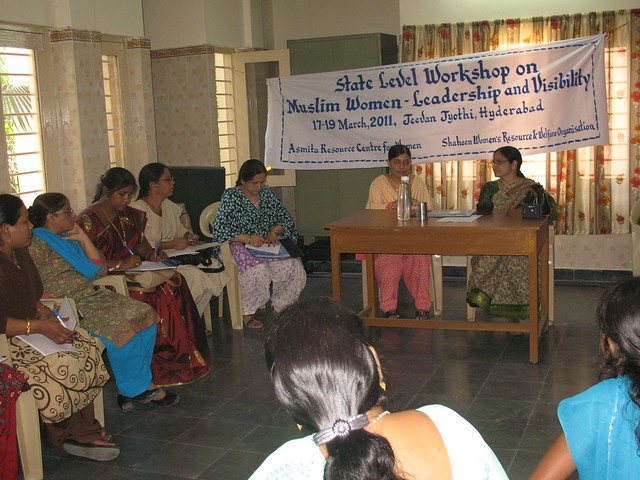By Nikhat Fatima for TwoCircles.net
A workshop for Muslim women activists on ‘Leadership and visibility’ was organized by Asmita Resource Centre for Women in Hyderabad from 17-19 March, 2011. Nineteen women representing ten different organizations from the state of Andhra Pradesh participated.
The workshop taking a cue from the conference held in London by the same name focused on issues of political visibility of the Muslim woman.
Why is the Muslim woman invisible? Not only in the political scenario but in all other spheres as well. Was it always like this? Were there women social reformers among the Muslim women?
Interactive discussions led by the facilitators which began with ‘the personal is political’ cascaded into several topics which the participants were eager to talk about.

Nineteen women representing ten different organizations from the state of Andhra Pradesh participated in the workshop in Hyderabad in March.
While discussing about the social reformers among the Muslim women of Andhra Pradesh the prominent ones were Sugra Humayun Mirza the first woman activist in Hyderabad who worked for women’s rights, dignity and self respect. She actively promoted education and established schools for girls way back in 1919!\.
Then there is Masuma Begum who contested elections in 1952 from the Hyderabad constituency and represented her constituency for eleven years. She then went on to become the Minister for Social Welfare in 1962.
Jamalunissa Baji was a rebel with a cause. She was active in political movements during 1945-47. She also formed small groups of women to spread awareness about political movements and bring them into the mainstream politics.
Despite having such dynamic exemplary Muslim women from the past what is hindering the women today in these modern times when education is accessible and several social barriers have been broken down?
There is not one simple reason which we can pin point and set right. There are myriad reasons all so complex that only a collective strength can break the walls of discrimination and marginalization, the patriarchal set up, the stereotypes, the politics of religion and all other encumbering structures.
The interactive discussion on politics took a slightly different turn when the matter of the infamous ‘Police Action’ came up. Muslims were hunted down and killed during that time and no one really likes to rake up that issue as it not only brings out unpleasant memories but also many skeletons from the cupboard.
Were the Razakars known as the private army of the Nizam really responsible for the Police Action? Did it solely comprise Muslims? Was Nizam a communal ruler? Many of these questions have been answered partially by the selective histography we get to read today where what is considered ‘essential’ to those ruling is highlighted and the real facts are suppressed.
Thankfully we had Kaneez Fatima in the workshop who is with the Civil Liberties Monitoring committee and has also done some research on the Razakar Movement and the Telangana Movement. She threw light on most of the facts of Hyderabad History. Nizam VII has been coloured as communal but all that he wanted was to remain independent whereas his close advisor Razvi the architect of the Razakar army wanted to join Pakistan. Razakars, she revealed, comprised of people other than Muslims. Yet when you talk about razakars, it is known as the ‘Muslim Militia’.
As for the Telangana Movement, of late, Muslims seem to be receding from the movement under the assumption that the formation of the separate state ‘Telangana’ might yet again prove dangerous to the Muslim population. The reason being the entry of the Hindutva forces in the telangana struggle. With the Hindutva forces supporting the cause, Muslims have reason to think that this movement is anti-Muslim. But their withdrawal will only result again in their marginalization and backwardness which is perhaps just what the Hindutva groups want.
Hence it is better if the Muslims stick on and stay in the struggle for Telangana. Perhaps their hopes will come true once Telangana is formed.
Apart from the well known issues of poverty, unemployment, low levels of education and of awareness, unfair interpretation of laws leading to double discrimination of the Muslim women, the issue of dowry was again brought up but from a different perspective.
Although ‘jahez’ or dowry is now also called ‘jode ki raqam’ in Hyderabad is un-Islamic as per many people, some participants said that in their work on anti-dowry they counter this argument from the males that even our prophet gave some articles to his daughter in marriage. So what if it those were frugal items? Does it not sum up to as dowry? What is wrong if in these modern times people give more than what the prophet gave his daughter because they can afford it and times have changed? This way they are justifying the custom of dowry and claiming that it is indeed Islamic and not un-Islamic as most of us women say.
So it remains to be decided whether the practice of dowry is really un-Islamic? Is it alright to call it an Islamic practice and then make unjust greedy demands for dowry which leave the parents of the girl in heavy debts?
This matter needs to be resolved at the community level.
At the end of the third day, all the participants and the facilitators agreed that the focus should be on ‘Aman aur Taalim’ thus shifting the focus from leadership and visibility.
What good is leadership if there is no taalim and what good is taalimif there is no aman?

